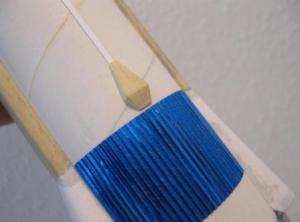

A magnetometer was attached to the top of the mast below the omnidirectional antenna. The scientific experiments were mounted on the instrument mast and base. Thermal control was achieved through the use of passive reflecting and absorbing surfaces, thermal shields, and movable louvers. Overall timing and control was performed by a digital Central Computer and Sequencer. The Sun and Earth were used as references for attitude stabilization. Attitude control with a 1 degree pointing error was maintained by a system of nitrogen gas jets. The hydrazine was ignited using nitrogen tetroxide and aluminium oxide pellets, and thrust direction was controlled by four jet vanes situated below the thrust chamber. Propulsion for midcourse maneuvers was supplied by a monopropellant (anhydrous hydrazine) 225 N retro-rocket. Communications consisted of a 3-watt transmitter capable of continuous telemetry operation, the large high gain directional dish antenna, a cylindrical omnidirectional antenna at the top of the instrument mast, and two command antennas, one on the end of either solar panel, which received instructions for midcourse maneuvers and other functions. A power-switching and booster regulator device controlled the power flow. Those panels powered the craft directly or recharged a 1,000-watt-hour sealed silver-zinc cell battery, which was to be used before the panels were deployed, when the panels were not illuminated by the Sun, and when loads were heavy. The Mariner 1 power system consisted of the two solar cell wings, one Template:Convert/xx/AonSoff ( Template:Convert/xx/AonSoff) and the other, Template:Convert/xx/AonSoff ( Template:Convert/xx/AonSoff), with a 31 cm ( Template:Convert/pround in) dacron extension (a solar sail) to balance the solar pressure on the panels. Attached by an arm to one side of the base and extending below the spacecraft was a large directional dish antenna. Attached to either side of the base were rectangular solar panel wings with a total span of 5.05 meters and width of 0.76 meters ( Template:Convert/x/AonSoff).

On top of the base, was a tall pyramid-shaped mast on which the science experiments were mounted which brought the total height of the spacecraft to 3.66 m ( Template:Convert/pround ft). Mariner 1 consisted of a hexagonal base, 1.04 meters (m, Template:Convert/pround ft) across and 0.36 m thick ( Template:Convert/LoffAonSon), which contained six magnesium chassis housing the electronics for the science experiments, communications, data encoding, computing, timing, and attitude control and the power control, battery, and battery charger, as well as the attitude control gas bottles and the rocket engine. The Mariner 1 spacecraft was identical to Mariner 2, launched 27 August 1962. 2.2.1 "The most expensive hyphen in history".2.2 Alternate guidance system failure explanations.The probe's mission was accomplished by Mariner 2 which launched 5 weeks later.
ATLAS AGENA CRASH SOFTWARE
The role of software error in the launch failure remains somewhat mysterious in nature, shrouded in the ambiguities and conflicts among (and in some accounts, even within) the various accounts, official and otherwise. The radio transponder continued to transmit signals for 64 seconds after the destruct command had been sent. The destruct command was sent 6 seconds before separation, after which the launch vehicle could not have been destroyed. Faulty application of the guidance commands made steering impossible and were directing the spacecraft towards a crash, possibly in the North Atlantic shipping lanes or in an inhabited area. The booster had performed satisfactorily until an unscheduled yaw-lift (northeast) maneuver was detected by the range safety officer. Īccording to NASA's current account for the public: With the craft effectively uncontrolled, a range safety officer ordered its destructive abort 294.5 seconds after launch. Shortly after takeoff the rocket responded improperly to commands from the guidance systems on the ground, setting the stage for an apparent software-related guidance system failure.

It was launched aboard an Atlas-Agena rocket on July 22, 1962. Mariner 1 was the first spacecraft of the American Mariner program, designed for a planetary flyby of Venus.


 0 kommentar(er)
0 kommentar(er)
